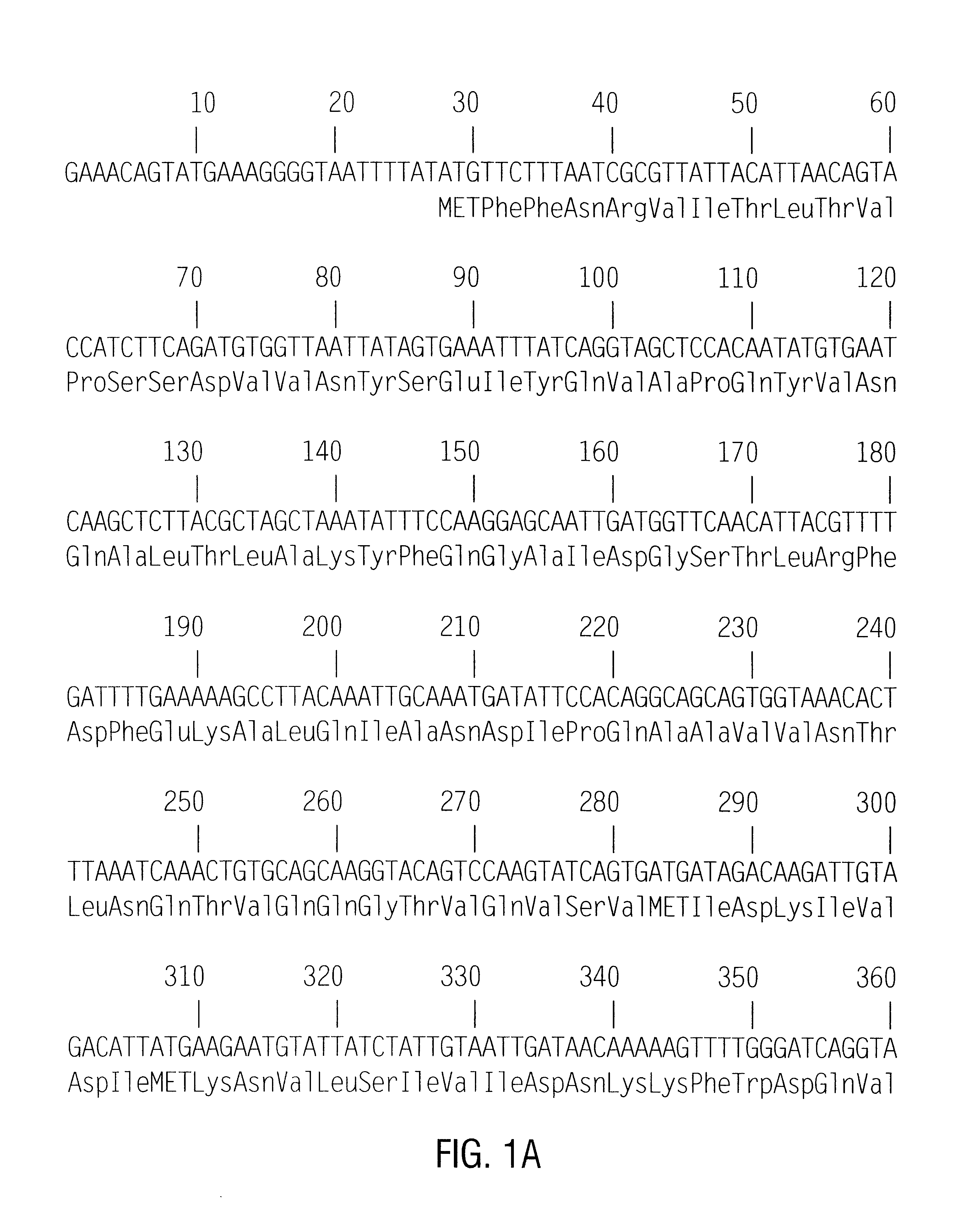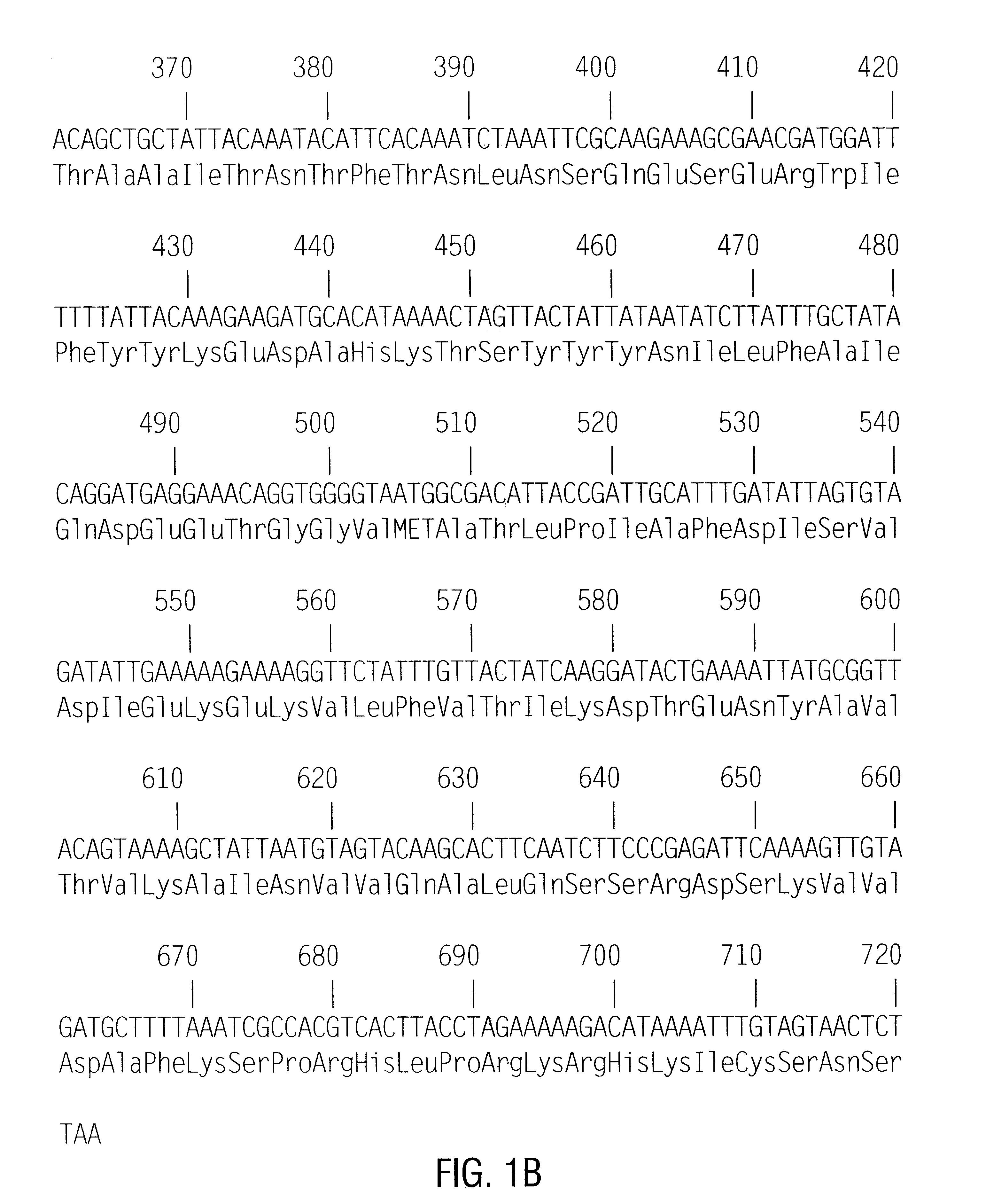Bacillus thuringiensis CryET29 compositions toxic to coleopteran insects and Ctenocephalides SPP
a technology of ctenocephalides and bacillus thuringiensis, which is applied in the field of molecular biology, can solve the problems of insect feeding stoppage, insect death, and toxic crystal protein, and achieve the effect of remarkable insecticidal activity
- Summary
- Abstract
- Description
- Claims
- Application Information
AI Technical Summary
Benefits of technology
Problems solved by technology
Method used
Image
Examples
example 1
5.1 Example 1
Isolation of B. thuringiensis EG4096
Crop dust samples were obtained from various sources throughout the U.S. and abroad, typically grain storage facilities. The crop dust samples were treated and spread on agar plates to isolate individual Bacillus-type colonies as described (Donovan et al., 1993). EG4096 is a wild-type B. thuringiensis strain isolated from a crop dust sample from Thailand. Phase contrast microscopy was used to visually examine the crystal morphology of the bacterial colonies from this crop dust. The colony designated EG4096 contained endospores and crystalline inclusions of a unique morphology resembling short needles. The array of plasmids native to strain EG4096 is also unique.
Insect bioassay of this wild-type B. thuringiensis strain determined that it had insecticidal activity against larvae of coleopteran insects, including Southern corn rootworm, western corn rootworm, Colorado potato beetle, red flour beetle, and Japanese beetle. EG4096 also exhi...
example 2
5.2 Example 2
Evaluation of the Native Plasmids of B. thuringiensis Strain EG4096
The complement of native plasmids contained within isolated B. thuringiensis EG4096 was determined by modified Eckhardt agarose gel electrophoresis as described by Gonzalez et al., (1982). The pattern of native plasmids did not correspond to patterns of typical known serovars (Carlton and Gonzalez, 1985). The plasmid sizes are 5.0, 7.2, 6.0 (open circular), 39, 80 and 100 MDa.
example 3
5.3 Example 3
Evaluation of the Crystal Protein of B. thuringiensis EG4096
EG4096 was grown in DSM+glucose sporulation medium [0.8% (wt / vol) Difco nutrient broth, 0.5% (wt / vol) glucose, 10 mM K.sub.2 HPO.sub.4, 10 mM KH.sub.2 PO.sub.4, 1 mM Ca(NO.sub.3).sub.2, 0.5 mM MgSO.sub.4, 10 .mu.M MnCl.sub.2, 10 .mu.M FeSO.sub.4 ] for three days at 30.degree. C. during which the culture grew to stationary phase, sporulated and lysed, thus releasing the protein inclusions into the medium. The cultures were harvested by centrifugation which pelleted the spores and crystals. The pellet was washed in a solution of 0.005% Triton X-100.RTM., 2 mM EDTA and recentrifuged. The washed pellet was resuspended at one-tenth the original volume of 0.005% Triton X-100.RTM., 2 mM EDTA.
Crystal protein was solubilized from the spores-crystals suspension by incubating the suspension in solubilization buffer [0.14 M Tris-HCl pH 8.0, 2% (wt / vol) sodium dodecyl sulfate (SDS), 5% (vol / vol) 2-mercaptoethanol, 10% (vol / ...
PUM
| Property | Measurement | Unit |
|---|---|---|
| temperatures | aaaaa | aaaaa |
| molecular mass | aaaaa | aaaaa |
| molecular mass | aaaaa | aaaaa |
Abstract
Description
Claims
Application Information
 Login to View More
Login to View More - R&D
- Intellectual Property
- Life Sciences
- Materials
- Tech Scout
- Unparalleled Data Quality
- Higher Quality Content
- 60% Fewer Hallucinations
Browse by: Latest US Patents, China's latest patents, Technical Efficacy Thesaurus, Application Domain, Technology Topic, Popular Technical Reports.
© 2025 PatSnap. All rights reserved.Legal|Privacy policy|Modern Slavery Act Transparency Statement|Sitemap|About US| Contact US: help@patsnap.com


